回顾上期✈观光线路图:putAll() –> putMapEntries() –> tableSizeFor() –> resize() –> hash() –> putVal()…
本期与您继续一起砥砺前行:putVal() –> putTreeVal() –> find() –> balanceInsertion() –> rotateLeft()/rotateRight() –> treeifyBin()…
- transient int modCount; 记录HashMap变更次数,用于的迭代时fail-fast;
putVal
新值的hash与key与map中已存在的值相等时,且原值不为null,根据onlyIfAbsent判断是否替换(true时不替换)。
1 2 3 4 5 6 7 8 9 10 11 12 13 14 15 16 17 18 19 20 21 22 23 24 25 26 27 28 29 30 31 32 33 34 35 36 37 38 39 40 41 42 43
| final V putVal(int hash, K key, V value, boolean onlyIfAbsent, boolean evict) { Node<K,V>[] tab; Node<K,V> p; int n, i; if ((tab = table) == null || (n = tab.length) == 0) n = (tab = resize()).length; if ((p = tab[i = (n - 1) & hash]) == null) tab[i] = newNode(hash, key, value, null); else { Node<K,V> e; K k; if (p.hash == hash && ((k = p.key) == key || (key != null && key.equals(k)))) e = p; else if (p instanceof TreeNode) e = ((TreeNode<K,V>)p).putTreeVal(this, tab, hash, key, value); else { for (int binCount = 0; ; ++binCount) { if ((e = p.next) == null) { p.next = newNode(hash, key, value, null); if (binCount >= TREEIFY_THRESHOLD - 1) treeifyBin(tab, hash); break; } if (e.hash == hash && ((k = e.key) == key || (key != null && key.equals(k)))) break; p = e; } } if (e != null) { V oldValue = e.value; if (!onlyIfAbsent || oldValue == null) e.value = value; afterNodeAccess(e); return oldValue; } } ++modCount; if (++size > threshold) resize(); afterNodeInsertion(evict); return null; }
|
putTreeVal
1 2 3 4 5 6 7 8 9 10 11 12 13 14 15 16 17 18 19 20 21 22 23 24 25 26 27 28 29 30 31 32 33 34 35 36 37 38 39 40 41 42 43 44 45 46
| final TreeNode<K,V> putTreeVal(HashMap<K,V> map, Node<K,V>[] tab, int h, K k, V v) { Class<?> kc = null; boolean searched = false; TreeNode<K,V> root = (parent != null) ? root() : this; for (TreeNode<K,V> p = root;;) { int dir, ph; K pk; if ((ph = p.hash) > h) dir = -1; else if (ph < h) dir = 1; else if ((pk = p.key) == k || (k != null && k.equals(pk))) return p; else if ((kc == null && (kc = comparableClassFor(k)) == null) || (dir = compareComparables(kc, k, pk)) == 0) { if (!searched) { TreeNode<K,V> q, ch; searched = true; if (((ch = p.left) != null && (q = ch.find(h, k, kc)) != null) || ((ch = p.right) != null && (q = ch.find(h, k, kc)) != null)) return q; } dir = tieBreakOrder(k, pk); } TreeNode<K,V> xp = p; if ((p = (dir <= 0) ? p.left : p.right) == null) { Node<K,V> xpn = xp.next; TreeNode<K,V> x = map.newTreeNode(h, k, v, xpn); if (dir <= 0) xp.left = x; else xp.right = x; xp.next = x; x.parent = x.prev = xp; if (xpn != null) ((TreeNode<K,V>)xpn).prev = x; moveRootToFront(tab, balanceInsertion(root, x)); return null; } } }
|
当前节点hash值(ph)与插入节点hash值(h)比较,
若ph > h(dir=-1),将新节点归为左子树;
若ph < h(dir=1),右子树;
否则即表示hash值相等,然后又对key进行了比较。
“kc = comparableClassFor(k)) == null”表示该类本身不可比(class C don’t implements Comparable);“dir = compareComparables(kc, k, pk)) == 0”表示k与pk对应的Class之间不可比。searched为一次性开关仅在p为root时生效,遍历比较左右子树中是否存在于插入节点相等的。
最后比到tieBreakOrder()中的“System.identityHashCode(a) <= System.identityHashCode(b)”,即对象的内存地址来生成的hashCode相互比较。堪称铁杵磨成针的比较。
这里循环的推进是靠“if ((p = (dir <= 0) ? p.left : p.right) == null)”,之前千辛万苦比较出的dir也在这使用。直到为空的左/右子树节点,插入新值(新值插入的过程参考下图理解)。
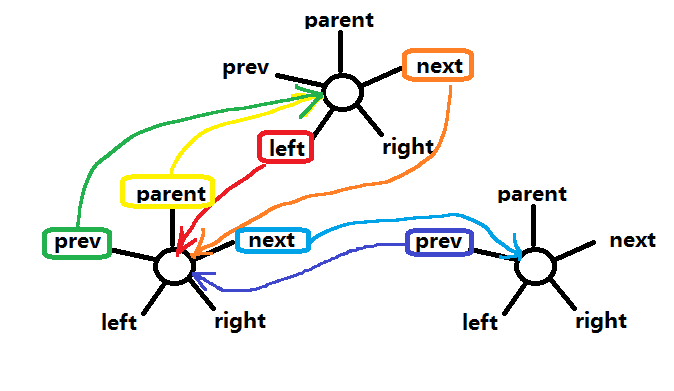
find
1 2 3 4 5 6 7 8 9 10 11 12 13 14 15 16 17 18 19 20 21 22 23 24 25 26
| final TreeNode<K,V> find(int h, Object k, Class<?> kc) { TreeNode<K,V> p = this; do { int ph, dir; K pk; TreeNode<K,V> pl = p.left, pr = p.right, q; if ((ph = p.hash) > h) p = pl; else if (ph < h) p = pr; else if ((pk = p.key) == k || (k != null && k.equals(pk))) return p; else if (pl == null) p = pr; else if (pr == null) p = pl; else if ((kc != null || (kc = comparableClassFor(k)) != null) && (dir = compareComparables(kc, k, pk)) != 0) p = (dir < 0) ? pl : pr; else if ((q = pr.find(h, k, kc)) != null) return q; else p = pl; } while (p != null); return null; }
|
有没有发现,如果当你看懂putTreeVal,类比find是不是变得很好理解了呢?
balanceInsertion
1 2 3 4 5 6 7 8 9 10 11 12 13 14 15 16 17 18 19 20 21 22 23 24 25 26 27 28 29 30 31 32 33 34 35 36 37 38 39 40 41 42 43 44 45 46 47 48 49 50 51 52 53 54 55 56 57 58 59
| static <K,V> TreeNode<K,V> balanceInsertion(TreeNode<K,V> root, TreeNode<K,V> x) { x.red = true; for (TreeNode<K,V> xp, xpp, xppl, xppr;;) { if ((xp = x.parent) == null) { x.red = false; return x; } else if (!xp.red || (xpp = xp.parent) == null) return root; if (xp == (xppl = xpp.left)) { if ((xppr = xpp.right) != null && xppr.red) { xppr.red = false; xp.red = false; xpp.red = true; x = xpp; } else { if (x == xp.right) { root = rotateLeft(root, x = xp); xpp = (xp = x.parent) == null ? null : xp.parent; } if (xp != null) { xp.red = false; if (xpp != null) { xpp.red = true; root = rotateRight(root, xpp); } } } } else { if (xppl != null && xppl.red) { xppl.red = false; xp.red = false; xpp.red = true; x = xpp; } else { if (x == xp.left) { root = rotateRight(root, x = xp); xpp = (xp = x.parent) == null ? null : xp.parent; } if (xp != null) { xp.red = false; if (xpp != null) { xpp.red = true; root = rotateLeft(root, xpp); } } } } } }
|
在插入新值后,可能打破了红黑树原有的“平衡”,balanceInsertion()的作用就是要维持这种“平衡”,保证最佳效率。所谓的红黑树“平衡”即:
①:所有节点非黑即红;
②:根为黑,叶子为null且为黑,红的两子节点为黑;
③:任一节点到叶子节点的黑子节点个数相同;
下面,以“(xp == (xppl = xpp.left))”简(chou)单(lou)的给大家画个图例(其中①②与源码注释相对应)。
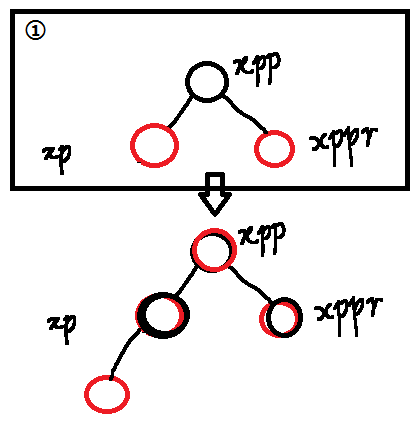
图②中打钩的都是合格的红黑树其实,图②右边方框内为左旋右旋节点关系变化图解。
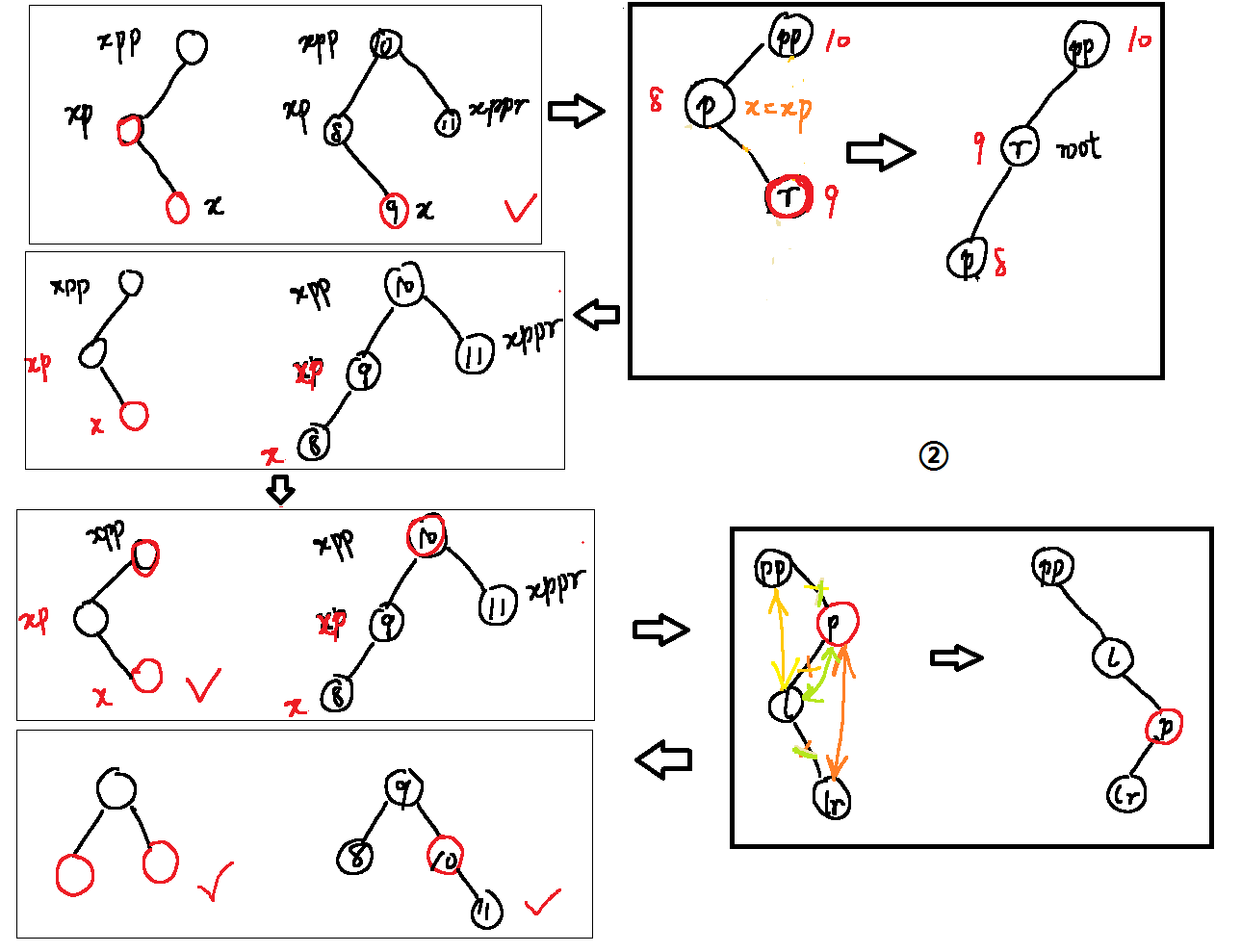
rotateLeft/rotateRight
1 2 3 4 5 6 7 8 9 10 11 12 13 14 15 16 17 18 19 20 21 22 23 24 25 26 27 28 29 30 31 32 33 34
| static <K,V> TreeNode<K,V> rotateLeft(TreeNode<K,V> root, TreeNode<K,V> p) { TreeNode<K,V> r, pp, rl; if (p != null && (r = p.right) != null) { if ((rl = p.right = r.left) != null) rl.parent = p; if ((pp = r.parent = p.parent) == null) (root = r).red = false; else if (pp.left == p) pp.left = r; else pp.right = r; r.left = p; p.parent = r; } return root; } static <K,V> TreeNode<K,V> rotateRight(TreeNode<K,V> root, TreeNode<K,V> p) { TreeNode<K,V> l, pp, lr; if (p != null && (l = p.left) != null) { if ((lr = p.left = l.right) != null) lr.parent = p; if ((pp = l.parent = p.parent) == null) (root = l).red = false; else if (pp.right == p) pp.right = l; else pp.left = l; l.right = p; p.parent = l; } return root; }
|
左旋右旋过程包含在上面的图例中了,另附上两张网上看到的动图便于大家理解。
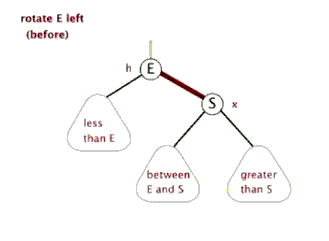
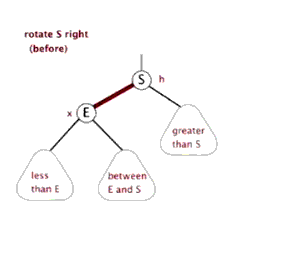
同时,在线红黑树插入删除动画演示【点我】,还不理解的童鞋可以亲自直观的试试。
treeifyBin
1 2 3 4 5 6 7 8 9 10 11 12 13 14 15 16 17 18 19 20
| final void treeifyBin(Node<K,V>[] tab, int hash) { int n, index; Node<K,V> e; if (tab == null || (n = tab.length) < MIN_TREEIFY_CAPACITY) resize(); else if ((e = tab[index = (n - 1) & hash]) != null) { TreeNode<K,V> hd = null, tl = null; do { TreeNode<K,V> p = replacementTreeNode(e, null); if (tl == null) hd = p; else { p.prev = tl; tl.next = p; } tl = p; } while ((e = e.next) != null); if ((tab[index] = hd) != null) hd.treeify(tab); } }
|
putVal()的treeifyBin()在链表中数目大于等于“TREEIFY_THRESHOLD - 1”时触发。当数目满足MIN_TREEIFY_CAPACITY时,链表将转为红黑树结构,否则继续扩容。treeify()类似putTreeVal()。
彩蛋
在上一篇中的resize方法中,当节点类型为树时,有个TreeNode.split方法这里稍作补充/温习。整体思路与上篇提到的链表相似,根据hash&bit(即oldCap)的结果拆分成保留顺序的高低两部分。只是变成了构造树(统一归于本篇来讲树)。值得注意的是,当拆完的树长度小于一定值便“降级”为链表。
1 2 3 4 5 6 7 8 9 10 11 12 13 14 15 16 17 18 19 20 21 22 23 24 25 26 27 28 29 30 31 32 33 34 35 36 37 38 39 40 41 42 43 44 45 46
| final void split(HashMap<K,V> map, Node<K,V>[] tab, int index, int bit) { TreeNode<K,V> b = this; TreeNode<K,V> loHead = null, loTail = null; TreeNode<K,V> hiHead = null, hiTail = null; int lc = 0, hc = 0; for (TreeNode<K,V> e = b, next; e != null; e = next) { next = (TreeNode<K,V>)e.next; e.next = null; if ((e.hash & bit) == 0) { if ((e.prev = loTail) == null) loHead = e; else loTail.next = e; loTail = e; ++lc; } else { if ((e.prev = hiTail) == null) hiHead = e; else hiTail.next = e; hiTail = e; ++hc; } } if (loHead != null) { if (lc <= UNTREEIFY_THRESHOLD) tab[index] = loHead.untreeify(map); else { tab[index] = loHead; if (hiHead != null) loHead.treeify(tab); } } if (hiHead != null) { if (hc <= UNTREEIFY_THRESHOLD) tab[index + bit] = hiHead.untreeify(map); else { tab[index + bit] = hiHead; if (loHead != null) hiHead.treeify(tab); } } }
|
untreeify/treeify
1 2 3 4 5 6 7 8 9 10 11 12 13 14 15 16 17 18 19 20 21 22 23 24 25 26 27 28 29 30 31 32 33 34 35 36 37 38 39 40 41 42 43 44 45 46 47 48 49 50 51 52 53 54
| final Node<K,V> untreeify(HashMap<K,V> map) { Node<K,V> hd = null, tl = null; for (Node<K,V> q = this; q != null; q = q.next) { Node<K,V> p = map.replacementNode(q, null); if (tl == null) hd = p; else tl.next = p; tl = p; } return hd; } final void treeify(Node<K,V>[] tab) { TreeNode<K,V> root = null; for (TreeNode<K,V> x = this, next; x != null; x = next) { next = (TreeNode<K,V>)x.next; x.left = x.right = null; if (root == null) { x.parent = null; x.red = false; root = x; } else { K k = x.key; int h = x.hash; Class<?> kc = null; for (TreeNode<K,V> p = root;;) { int dir, ph; K pk = p.key; if ((ph = p.hash) > h) dir = -1; else if (ph < h) dir = 1; else if ((kc == null && (kc = comparableClassFor(k)) == null) || (dir = compareComparables(kc, k, pk)) == 0) dir = tieBreakOrder(k, pk); TreeNode<K,V> xp = p; if ((p = (dir <= 0) ? p.left : p.right) == null) { x.parent = xp; if (dir <= 0) xp.left = x; else xp.right = x; root = balanceInsertion(root, x); break; } } } } moveRootToFront(tab, root); }
|






